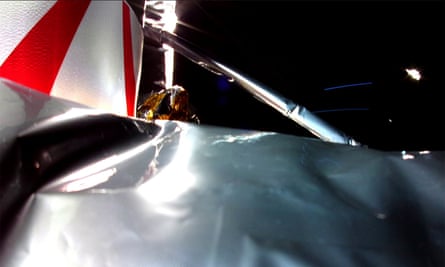The first moon lander to launch from the US in half a century will not make it to the lunar surface due to a fuel leak, its operators have announced, adding that their goal was now to travel as far as possible before losing power.
Peregrine 1, which is also the first commercial space probe to attempt a soft landing on the moon, suffered a “critical loss of propellant” hours after lift-off on Monday due to an “anomaly” in the propulsion system, according to Astrobotic, the US company behind the project.
After initially fearing that the spacecraft would not be able to orient itself towards the sun to charge its batteries, the team at Astrobotic announced it had successfully completed an “improvised manoeuvre” and the solar array was working.
However, in a later statement, the Pittsburgh-based company said its thrusters “could likely only operate for 40 more hours at most”, adding: “At this time, the goal is to get Peregrine as close to lunar distance as we can before it loses the ability to maintain its sun-pointing position and subsequently loses power.”

The lander, which is carrying Nasa scientific equipment, launched on the Vulcan Centaur rocket from Cape Canaveral, marking the first use of the powerful new rocket built by United Launch Alliance, a Boeing-Lockheed venture.
Peregrine was scheduled to land on the moon on 23 February, when it would have begun to gather data about the lunar surface to help research for planned future human missions.
Instruments on board include those that can measure radiation levels, surface and subsurface water ice, the magnetic field, and the extremely tenuous layer of gas called the exosphere. Also onboard are five small moon rovers, each weighing less than 60g and measuring 12cm across.
The lander also contains non-scientific payloads, including DNA from former US presidents, including George Washington, John F Kennedy and Dwight Eisenhower, which could now remain in space. The ashes of Gene Roddenberry, the creator of Star Trek, as well as those of former stars of the TV series, are also onboard.
With a successful landing now seen as impossible, the probe will do experiments in space before its batteries die.
Responding to reports of the lander’s failure, Nasa said it was working with Astrobotic to identify the root cause of the propulsion problem, adding: “Space is hard.”
https://news.google.com/rss/articles/CBMigQFodHRwczovL3d3dy50aGVndWFyZGlhbi5jb20vc2NpZW5jZS8yMDI0L2phbi8wOS9uYXNhLXBlcmVncmluZS0xLXVzLWxhbmRlci13aWxsLW5vdC1tYWtlLWl0LXRvLXRoZS1tb29ucy1zdXJmYWNlLWR1ZS10by1mdWVsLWxlYWvSAYEBaHR0cHM6Ly9hbXAudGhlZ3VhcmRpYW4uY29tL3NjaWVuY2UvMjAyNC9qYW4vMDkvbmFzYS1wZXJlZ3JpbmUtMS11cy1sYW5kZXItd2lsbC1ub3QtbWFrZS1pdC10by10aGUtbW9vbnMtc3VyZmFjZS1kdWUtdG8tZnVlbC1sZWFr?oc=5
2024-01-09 14:06:00Z
CBMigQFodHRwczovL3d3dy50aGVndWFyZGlhbi5jb20vc2NpZW5jZS8yMDI0L2phbi8wOS9uYXNhLXBlcmVncmluZS0xLXVzLWxhbmRlci13aWxsLW5vdC1tYWtlLWl0LXRvLXRoZS1tb29ucy1zdXJmYWNlLWR1ZS10by1mdWVsLWxlYWvSAYEBaHR0cHM6Ly9hbXAudGhlZ3VhcmRpYW4uY29tL3NjaWVuY2UvMjAyNC9qYW4vMDkvbmFzYS1wZXJlZ3JpbmUtMS11cy1sYW5kZXItd2lsbC1ub3QtbWFrZS1pdC10by10aGUtbW9vbnMtc3VyZmFjZS1kdWUtdG8tZnVlbC1sZWFr
Tidak ada komentar:
Posting Komentar